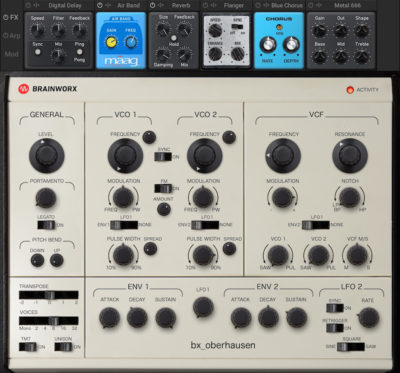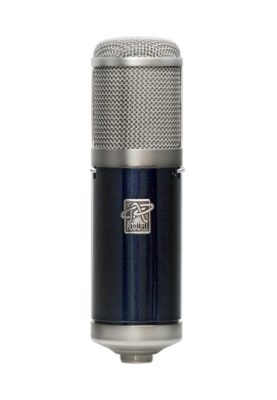New Gear Alert: Plugin Alliance’s Debut Synth, Bass Station II x Aphex Twin, Delphos II Condenser by Roswell & More
Plugin Alliance releases debut virtual instrument, bx_oberhausen.

With over a decade of designing world-class mixing and mastering tools, Plugin Alliance releases their debut virtual instrument, bx_oberhausen.
As Plugin Alliance’s first-ever virtual instrument, bx_oberhausen revisits an acclaimed analog synthesizer expander module much loved by generations of musicians for its sought-after sound. The sound itself is reliant on fully-analog, discrete circuits and a classic state-variable 2-pole filter.
bx_oberhausen offers full polyphony of up to 32 voices and includes Plugin Alliance’s TMT (Tolerance Modeling Technology). Its voices can be combined into a powerful Unison mode, which forms a complex, rich, and authentic analog sound. “Virtual vitamin” boosting brings Mid/Side (M/S) technology to bx_oberhausen, and you can select which part of the sound passes through the filter section and which part does not. Results ranging from a solid bass foundation to crazy stereo processing are all possible.
bx_oberhausen is available now for an introductory price of $179 (reg. $249).
Novation announces Bass Station II x Aphex Twin firmware update.

Aphex Twin and Novation collaborate to implement key new features into Bass Station II firmware v4.14.
The latest firmware update for Bass Station II adds 5 powerful and innovative new features to Novation’s hugely popular monosynth, all of them developed in response to user feedback and requests—one of those users being particularly noteworthy…
AFX Mode: Electronic music legend Richard James, aka Aphex Twin, has already played an instrumental part in the Bass Station II story, having provided guidance for the implementation of the micro-tuning added with firmware v2.5. His conceptual contribution to v4.14 is even more profound.
James envisioned the decidedly radical notion of having a discrete set of synthesis parameters assigned to each note of Bass Station II, either variations on a “seed” patch, or disparate sounds designed to constitute a chimeric whole.
AFX Mode is the realisation of James’ out-there concept. Put simply, it lets you modify your Bass Station II patch on a key-by-key basis. Use it to introduce subtle changes to a sound as you play up and down the keyboard; divide the keyboard into multiple zones (one per key if you like!), each playing its own sound; or create entire drum kits in a single preset for triggering manually or via the Arpeggiator. It’s a truly inspiring feature that really does open up a whole new world of sound design and performance possibilities.
Bass Station v4.14 also offers new fixed duration envelopes, extended sub-oscillator control, oscillator glide diverge, and envelope re-trigger count.
Check out a video of AFX Mode in action here.
Bass Station II firmware v4.14 is a free update for all Bass Station II users.
Roswell Pro Audio ships the Delphos II condenser mic.

Roswell Pro Audio releases the Delphos II microphone, a high-sensitivity large diaphragm condenser with an ultra-flat frequency response.
After a successful debut at the 2019 NAMM show, Roswell Pro Audio, maker of premium boutique microphones, is now shipping their new Delphos II all-purpose studio condenser microphone.
The original Delphos featured an un-hyped and natural frequency response, high sensitivity, and low self-noise. The Delphos II retains the characteristics of the original, and adds a 3rd polar pattern (Figure 8) and refined electronics designed to reduce ultrasonic noise. These new features are all housed in a larger body adorned in custom metallic blue paint.
Delphos II uses a highly optimized transformerless circuit, which provides a pristine, low-distortion signal path. Two switches provide a choice of Cardioid, Omni and Figure 8 polar patterns, as well as a 10dB pad. The mic has a frequency range of 20Hz to 16kHz, with a response curve carefully tailored to provide full lows, neutral mids, and high-frequency detail without sibilance. Its sensitivity is 40mV/Pa, with a self-noise level conservatively rated at 12dBA.
The mic ships in a custom, heavy-duty flight case with a proprietary Roswell Cutaway shock mount.
Delphos II is available now, priced at $999 MSRP.
Sound Credit releases first desktop software to generate ID codes for music.
Sound Credit has introduced a process that represents the highest quality standards for creating ISRCs, as well as a similar code, called the Global Release Identifier (GRid).
The rules and recommendations for creating these codes are built-in, so you do not need to memorize them. After creation, the codes are automatically organized and stored. Also, a convenient summary is emailed at the end of the process.
Sound Credit uses a new industry standard called the DDEX RIN during the creation of the codes. DDEX is a consortium of leading music companies including Universal, Warner, ASCAP, BMI, and PPL.
Check out a tutorial to the code generator here.
The code generator feature is available in the Sound Credit Publisher desktop application. For more information, click here; to download the Sound Credit Publisher free trial, click here.
Electro-Harmonix delivers the Switchblade Pro.

The Switchblade Pro by EHX is a feature-packed switching pedal offering mechanical bypass, volume control, and more.
The Switchblade Pro is a compact switching pedal with advanced features, including true mechanical bypass, soft switching, high quality/low noise buffers, volume controls for all input signals, and high headroom.
With Switchblade Pro, you can switch between two different amplifiers or turn both on at once. An additional amp can be added to the main output for a 3-amp setup. Footswitchable effects loops can run in series or parallel, and can swap order when run in series, and you can also mix and switch between 3 instruments/audio sources with individual volume controls sent to one amplifier.
Dry Level makes it ideal for bass players by mixing in the dry and processed signals to keep the low-end clear and focused, and true bypass helps avoid “tone suck” and noise from vintage pedals placed in the Switchblade Pro’s FX loops. Switchblade Pro provides an adjustable volume boost with up to 6dB of gain for each input.
Check out a video demo of Switchblade Pro here.
Switchblade Pro comes with an EHX 9.6DC200mA power supply and is available now for $123.50.
Please note: When you buy products through links on this page, we may earn an affiliate commission.







